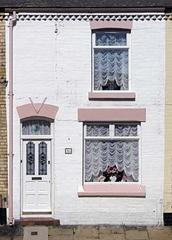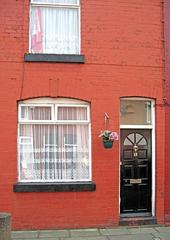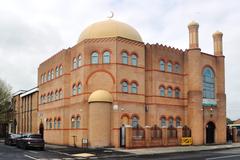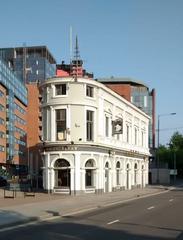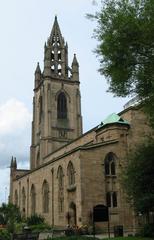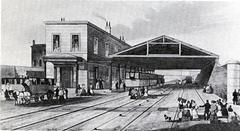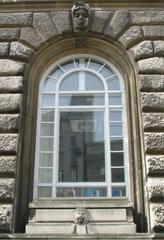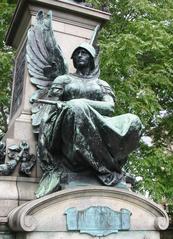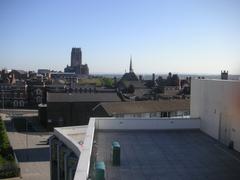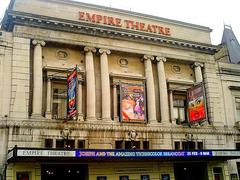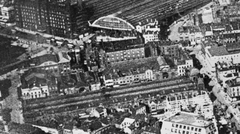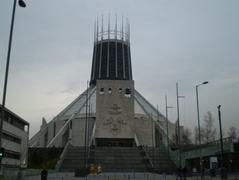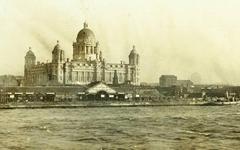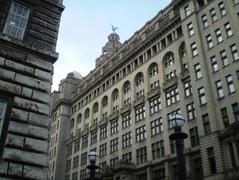
The Oratory Liverpool: Visiting Hours, Tickets, and Tourist Guide
Date: 04/07/2025
Introduction
Adjacent to the magnificent Liverpool Anglican Cathedral, The Oratory stands as one of Liverpool’s most significant architectural and historical treasures. Designed by John Foster Jr. between 1827 and 1829, this Grade I listed building is a remarkable example of Greek Revival architecture, originally built as a mortuary chapel for St James’s Cemetery. Today, The Oratory is celebrated for its neoclassical purity, moving funerary art, and enduring role in the city’s cultural heritage.
This comprehensive guide covers everything you need to know about visiting The Oratory Liverpool, from opening hours and ticket information to highlights of its architecture, collections, and nearby attractions. Whether you are an architecture enthusiast, history buff, or a curious traveler, this article will help you plan a memorable visit to one of Liverpool’s most evocative historical sites (National Museums Liverpool, Kiddle: The Oratory, Liverpool, Liverpool Cathedral).
Table of Contents
- Introduction
- Historical Background
- Architecture and Artistic Highlights
- Visiting The Oratory Liverpool
- Notable Features and Collections
- Nearby Attractions
- Conservation and Community Value
- Practical Visitor Information & Tips
- Frequently Asked Questions (FAQ)
- Conclusion
- References and Further Reading
Historical Background
Origins and Purpose
Constructed as a mortuary chapel for St James’s Cemetery, The Oratory served Liverpool’s expanding population during the Industrial Revolution. It provided a dignified setting for funeral services before burials and reflected a growing societal emphasis on commemoration and public mourning.
Architectural Significance
The Oratory is widely lauded as one of the UK’s purest examples of Greek Revival architecture. Its imposing Doric porticos, lack of external windows, and harmonious proportions were designed to evoke the solemnity of ancient Greek temples, adapted for Christian rites (Kiddle: The Oratory, Liverpool). The use of high-quality ashlar sandstone and a dramatic central skylight further reinforce its classical character.
Transition and Preservation
With the closure of St James’s Cemetery in the mid-20th century, The Oratory ceased its original function and fell into neglect. In 1986, stewardship was assumed by National Museums Liverpool, who have since preserved and repurposed the building as a heritage site and sculpture gallery.
Architecture and Artistic Highlights
Exterior
The Oratory’s exterior is modeled directly on a Greek Doric temple, featuring robust columns, plain capitals, and no bases, in strict adherence to ancient Greek architectural rules. Two porticos—one at each end—create a sense of grandeur and monumentality. The absence of windows is a deliberate design choice, enhancing the building’s solemnity and focusing attention on the ceremonial space within (Kiddle: The Oratory, Liverpool).
Interior
Inside, the coffered ceiling and Ionic columns continue the classical theme. The skylight admits soft, natural light, creating a contemplative atmosphere ideal for the display of funerary sculptures. The interior design emphasizes proportion, symmetry, and the interplay of light and shadow, rather than ornate decoration.
Artistic Integration
Housed within The Oratory is a curated collection of 19th-century funerary monuments and neoclassical sculptures, including works by John Gibson and Richard Westmacott. These pieces provide insight into Victorian attitudes toward death and commemoration and are displayed in a manner that complements the building’s architectural purity (Kiddle: The Oratory, Liverpool).
Visiting The Oratory Liverpool
Location
- Address: Upper Duke Street, Liverpool L1 7AZ, adjacent to Liverpool Anglican Cathedral.
Visiting Hours
The Oratory is open on select days, typically from 10:00 AM to 4:00 PM, often during special events, heritage open days, or pre-arranged guided tours. Visiting hours may change, so always consult the official National Museums Liverpool website or Liverpool Cathedral for current information.
Tickets and Admission
- Admission: Free during open days and events; donations welcome to support conservation.
- Guided Tours: Offered periodically, especially during heritage events. Advance booking is recommended due to limited capacity.
- Group Visits: Should be arranged in advance.
Accessibility
- The Oratory’s historic structure presents some accessibility challenges. While the entrance is at ground level, some uneven surfaces and steps remain inside.
- Accessible toilets are available at Liverpool Cathedral nearby.
- Visitors with mobility needs are advised to contact the venue in advance.
Getting There
- By Train: 15-minute walk from Liverpool Lime Street or Central stations.
- By Bus: Numerous city center routes stop nearby.
- By Car: Limited on-street parking; public transport or walking is recommended.
Notable Features and Collections
- Doric Porticos: Examine the robust columns and classical entablature.
- Ashlar Stonework: Appreciate the precision and durability of the stone blocks.
- Coffered Ceiling and Ionic Columns: Look for the geometric ceiling pattern and interior column details.
- Funerary Sculptures: View works by John Gibson, Richard Westmacott, and other 19th-century artists.
- Cast Iron Railings: The surrounding Grade II listed railings feature classical motifs.
Nearby Attractions
- Liverpool Anglican Cathedral: The UK’s largest cathedral, with panoramic city views.
- St James’s Cemetery: A historic burial ground with notable monuments and green spaces.
- Sudley House: Victorian art and interiors (National Museums Liverpool).
- Walker Art Gallery, St George’s Hall, World Museum: All within walking distance.
- Georgian Quarter: Home to cultural venues, Hope Street theatres, and the Philharmonic Dining Rooms.
Conservation and Community Value
The Oratory is managed and maintained by National Museums Liverpool’s Estates team, ensuring its protection as a Grade I listed building. Its preservation allows ongoing public access, educational programming, and a quiet space for reflection within the bustling city (National Museums Liverpool).
Practical Visitor Information & Tips
- Check opening hours before visiting, as they vary by season and event.
- Dress appropriately—the building is unheated and can be chilly in colder months.
- Photography is permitted without flash or tripods for personal use.
- Combine your visit with other nearby cultural sites for a richer experience.
- Virtual tours and additional information may be available on the official website.
Frequently Asked Questions (FAQ)
Q: What are The Oratory’s visiting hours?
A: Typically 10:00 AM to 4:00 PM on select days; confirm via the official website.
Q: Is there an admission fee or ticket required?
A: Admission is free during open days and events, but donations are encouraged.
Q: Are guided tours available?
A: Yes, book in advance during heritage events or via the Liverpool Museums website.
Q: Is The Oratory accessible for wheelchair users?
A: There are some limitations due to the historic building; contact the venue ahead for details.
Q: Can I take photographs inside?
A: Personal photography is permitted. Commercial photography requires permission.
Q: What are the best times to visit?
A: Spring and summer, during heritage open days or special events, offer the best access and lighting.
Conclusion
The Oratory Liverpool is a rare gem that combines architectural grandeur, Victorian funerary art, and a powerful sense of history. Managed by National Museums Liverpool, it stands as a peaceful, contemplative space amid the city’s vibrant Georgian Quarter. Free to enter and rich in cultural value, The Oratory is a must-see for anyone interested in Liverpool’s past and its extraordinary architectural heritage. Plan ahead, check current opening times, and consider joining a guided tour to fully appreciate this unique site.
For more information, updates, and virtual content, visit the National Museums Liverpool website, follow related social media channels, and consider downloading the Audiala app for immersive audio guides and the latest event news.
Images:
- The Oratory Liverpool exterior (alt: “The Oratory Liverpool exterior showcasing Greek Revival architecture”)
- Victorian funerary sculptures at The Oratory (alt: “Victorian funerary sculptures displayed inside The Oratory Liverpool”)
External Links:
- National Museums Liverpool
- Kiddle: The Oratory, Liverpool
- Liverpool Cathedral
- QuestoApp: The Oratory, Liverpool
- GPSmyCity: The Oratory Liverpool
Map and Virtual Tour:
Check the National Museums Liverpool website for virtual tour links and a map of the location.
References and Further Reading
- The Oratory Liverpool: Visiting Hours, Tickets, History & Nearby Attractions, 2025, National Museums Liverpool (https://www.liverpoolmuseums.org.uk/oratory)
- Visiting The Oratory Liverpool: Architecture, Tickets, and Historical Insights, 2025, Kiddle (https://kids.kiddle.co/The_Oratory,_Liverpool)
- The Oratory Visiting Hours and Liverpool Historical Sites: A Complete Guide to Exploring The Oratory in Liverpool, 2025, QuestoApp and GPSmyCity (https://questoapp.com/places-to-visit/liverpool/anglican-cathedral-entrance-the-oratory)
- Visiting the Oratory Liverpool: Hours, Tickets, and Essential Visitor Tips, 2025, Liverpool Museums and Liverpool Cathedral (https://www.liverpoolmuseums.org.uk/oratory)





